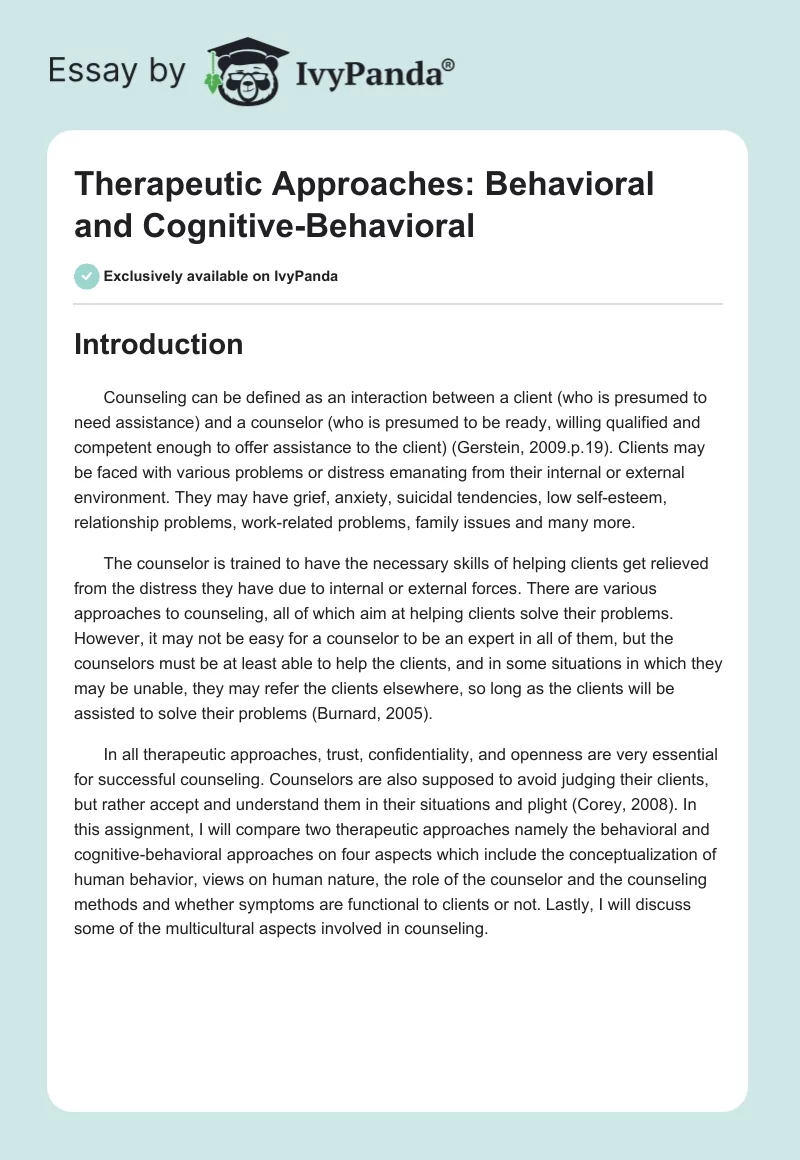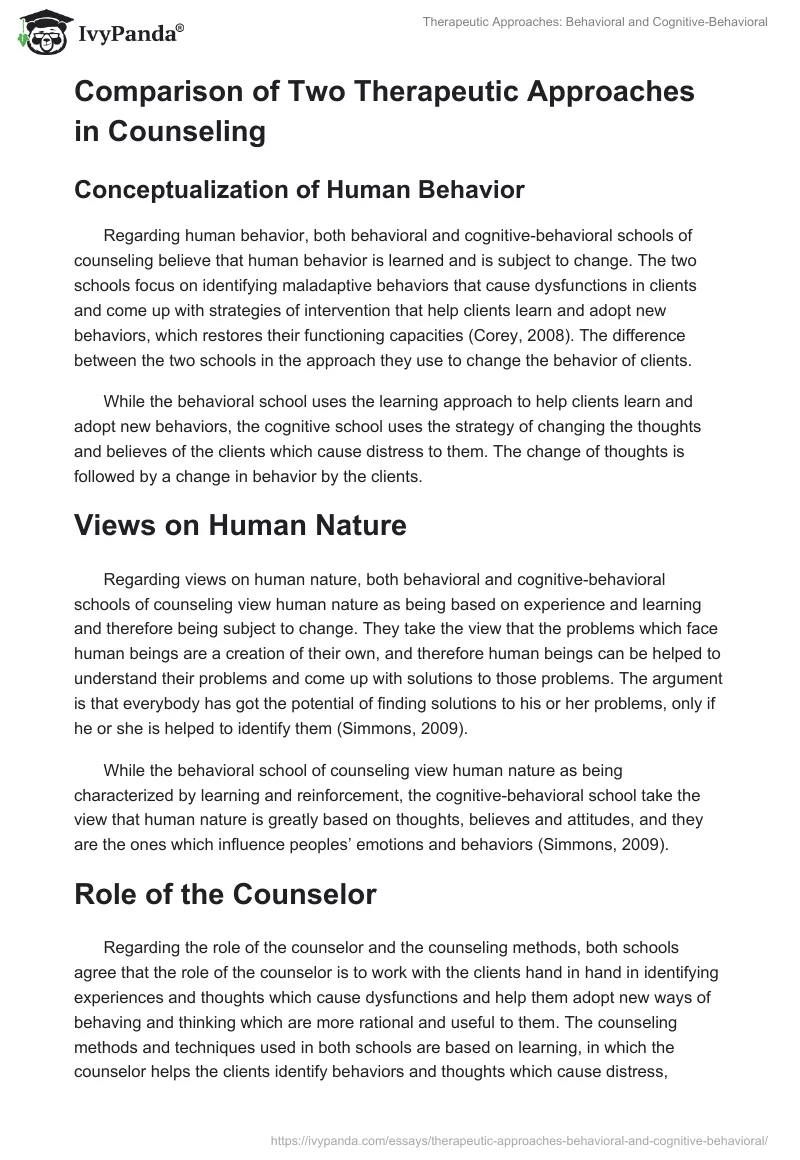Introduction
Counseling can be defined as an interaction between a client (who is presumed to need assistance) and a counselor (who is presumed to be ready, willing qualified and competent enough to offer assistance to the client) (Gerstein, 2009.p.19). Clients may be faced with various problems or distress emanating from their internal or external environment. They may have grief, anxiety, suicidal tendencies, low self-esteem, relationship problems, work-related problems, family issues and many more.
The counselor is trained to have the necessary skills of helping clients get relieved from the distress they have due to internal or external forces. There are various approaches to counseling, all of which aim at helping clients solve their problems. However, it may not be easy for a counselor to be an expert in all of them, but the counselors must be at least able to help the clients, and in some situations in which they may be unable, they may refer the clients elsewhere, so long as the clients will be assisted to solve their problems (Burnard, 2005).
In all therapeutic approaches, trust, confidentiality, and openness are very essential for successful counseling. Counselors are also supposed to avoid judging their clients, but rather accept and understand them in their situations and plight (Corey, 2008). In this assignment, I will compare two therapeutic approaches namely the behavioral and cognitive-behavioral approaches on four aspects which include the conceptualization of human behavior, views on human nature, the role of the counselor and the counseling methods and whether symptoms are functional to clients or not. Lastly, I will discuss some of the multicultural aspects involved in counseling.
Comparison of Two Therapeutic Approaches in Counseling
Conceptualization of Human Behavior
Regarding human behavior, both behavioral and cognitive-behavioral schools of counseling believe that human behavior is learned and is subject to change. The two schools focus on identifying maladaptive behaviors that cause dysfunctions in clients and come up with strategies of intervention that help clients learn and adopt new behaviors, which restores their functioning capacities (Corey, 2008). The difference between the two schools in the approach they use to change the behavior of clients.
While the behavioral school uses the learning approach to help clients learn and adopt new behaviors, the cognitive school uses the strategy of changing the thoughts and believes of the clients which cause distress to them. The change of thoughts is followed by a change in behavior by the clients.
Views on Human Nature
Regarding views on human nature, both behavioral and cognitive-behavioral schools of counseling view human nature as being based on experience and learning and therefore being subject to change. They take the view that the problems which face human beings are a creation of their own, and therefore human beings can be helped to understand their problems and come up with solutions to those problems. The argument is that everybody has got the potential of finding solutions to his or her problems, only if he or she is helped to identify them (Simmons, 2009).
While the behavioral school of counseling view human nature as being characterized by learning and reinforcement, the cognitive-behavioral school take the view that human nature is greatly based on thoughts, believes and attitudes, and they are the ones which influence peoples’ emotions and behaviors (Simmons, 2009).
Role of the Counselor
Regarding the role of the counselor and the counseling methods, both schools agree that the role of the counselor is to work with the clients hand in hand in identifying experiences and thoughts which cause dysfunctions and help them adopt new ways of behaving and thinking which are more rational and useful to them. The counseling methods and techniques used in both schools are based on learning, in which the counselor helps the clients identify behaviors and thoughts which cause distress, relearn them and replace them with other behaviors and thoughts which are more healthier than the previous ones (Simmons, 2009).
The role of the counselor in the behavioral school of counseling is that of a teacher, in the sense that he or she teaches and trains the clients on behavior modification. The technique used in this school is that of teaching, conditioning, and reinforcement of good behavior in the clients. On the other hand, the role of the counselor in the cognitive-behavioral school is that of an expert and an advisor of thoughts and how they affect peoples’ emotions and behaviors.
The counselor is responsible for identifying and monitoring the thinking patterns of the clients and offering advice to the clients from time to time on how best to improve their thinking processes. The technique used is that of helping the clients set goals for themselves and work towards achieving them as well as helping the clients solve their problems by changing their thinking processes and patterns. The goals set by the clients must, however, be realistic (Corey, 2008).
The Role of Symptoms in Clients
In reaction to the question of whether symptoms are functional to clients or not, both cognitive and behavioral approaches seem to disagree. The proponents of the behavioral approach (John and Carl) define behavior as a function of hereditary and environmental factors. One of the principles of the theory is that human behavior is learned, and is therefore subject to change. One way of changing the learned behavior is by altering the maladaptive behaviors in the client, which makes him or her adopt some symptoms for coping with the problem. The symptoms may be expressed in the form of some behaviors like drug and substance abuse.
The proponents of this theory further argue that the principles of social learning (reinforcement and modeling) may be applied in the counseling process to help the client forget old ways of living and adapt to new orientations in life. If for example, the person is an alcoholic, he or she may be taken to a rehabilitation center where alcohol is withdrawn gradually and replaced with something else which does not have similar effects. During the rehabilitation, the person is trained on how to live and survive in the absence of alcohol or drugs. The result, in this case, is a change of lifestyle by the client, through the acquisition of a new meaning in life accompanied by new behaviors (Corey, 2008).
Albert Ellis, who is a cognitive theorist, argues that symptoms emanate from clients’ irrational and illogical thinking. He goes on to argue that man is both a rational and irrational being (Corey, 2008). When a man is rational, the result is happiness, effectiveness, and competency in everything. When he is irrational, the result is unhappiness, self-pity, depression or in some cases neurosis. Ellis argued that unhappiness comes from within and therefore can be controlled as opposed to what comes from outside and cannot be controlled. According to him, therefore, symptoms have no role to play in a client because the client can avoid them through logical and rational reasoning (Corey, 2008).
The role of the counselor is, therefore, to help the client recognize the irrational, inconsistent and unrealistic perceptions and replace them with rational, reasonable and realistic thoughts or perceptions. If this is done, then the client will no longer depend on the symptoms to cope with the problem but will rather face the problem as it is. This can be of more help than applying defense mechanisms through hiding in symptoms (Corey, 2008).
Multicultural Aspects of Counseling
In both behavioral and cognitive-behavioral approaches, counselors put into consideration the multicultural aspects of counseling. These have to do with the objectivity of the counselor in his or her intervention. What this means is that the counselor should not allow cultural biases to influence his or her intervention. Multicultural aspects include things like stereotyping and prejudicing clients based on their culture which includes things like race, language, religion, tradition, ethnicity, and country of origin (Palmer & Laungani,1999).
Cultural stereotyping and prejudice in counseling may result in wrong diagnosis, intervention and consequently unsuccessful therapeutic intervention. This is not only unprofessional of the counselors but also unethical because the counselors are supposed to avoid any judgmental attitude towards their clients by being as objective as possible (Palmer & Laungani,1999).
Cultural stereotypes and prejudice may also lead to a lack of trust by the clients on the counselors, which may worsen the symptoms of the clients. Counselors are therefore supposed to properly study and understand the culture of the clients who they deal with. This understanding puts them in a better position to understand the clients better, which paves the way for a rapport between them. Good rapport between counselors and clients is very crucial for the clients to volunteer as much information about their problems as possible. It also enables clients and counselors to work out solutions that are based on the real problems and correct diagnosis. This minimizes the chances of relapsing on the part of the clients (Palmer & Laungani,1999).
References
Corey, G.,(2008). Case Approach to Counseling and Psychotherapy. Independence, KY: Cengage Learning Publishers.
Burnard, P. (2005). Counseling Skills for Health Professionals (4th ed.). Cheltenham, UK: Nelson Thornes.
Gerstein,L.H.(2009).International Handbook of Cross-Cultural Counseling: Cultural Assumptions and Practices Worldwide: Teller Road, CA: SAGE, p.19.
Palmer,S., & Laungani , P.(1999).Counseling in a multicultural society. Newbury Park, CA: SAGE.
Simmons, J. (2009). CBT for Beginners. Teller Road, CA: SAGE Publications.


